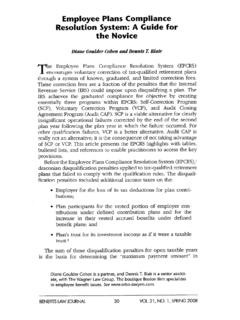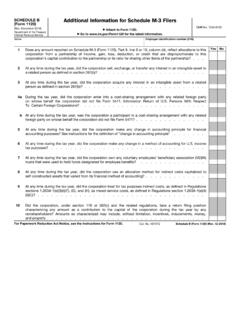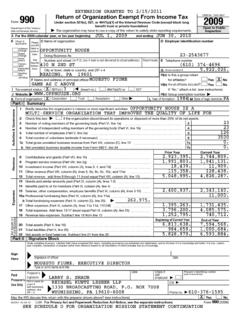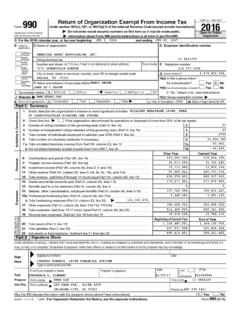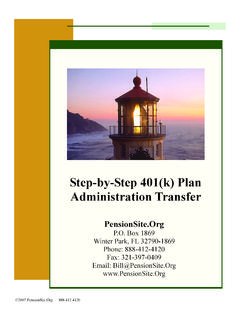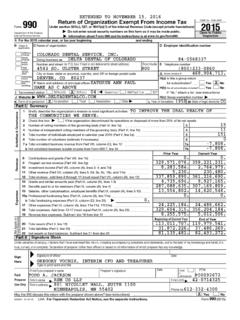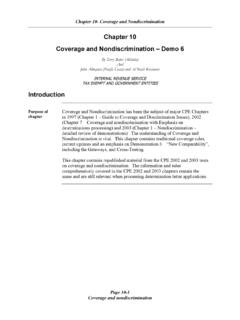Transcription of Month End Protocols Preparation for Monthly …
1 Month End Protocols Preparation for Monthly Financial Statements General Notes for Month / Year End Protocols For Small or Midsized Nonprofit Organizations Monthly A good rule of thumb is to print a trial balance and thoroughly check each Statement of Position (SOP) (old term balance sheet ) item, seeing that it reconciles to a bank statement or internal schedule (spreadsheet or list). A review of the Month s general ledger for income and expense transactions is wise to make sure that account assignments and activity allocations are correct for the Statement of Activities (SOA) (old term income statement or profit & loss ).
2 Some typical Monthly and annual adjustments follow: Reconcile each Bank Account During the reconciliation process, the following adjustments may be required: Credit Card Discounts (Decrease Cash/Increase Expense) Interest Earned (Increase Cash/Increase Interest Income) Bank Fees (Decrease Cash/Increase Bank Fees Expense) Voided Checks* (Increase Cash/Decrease Expense or Increase Accounts Payable) Investigate and resolve outstanding checks and uncleared deposits that are over 60-90 days aged.
3 *Do not void a check from a prior period that has been closed, as it will change reconciled cash balances. Use a Journal Entry to increase cash and increase miscellaneous income (or other appropriate account) in the current Month . Clear both the entry and the old check during the next bank reconciliation process. Reconcile Petty Cash and Change Funds At the end of each Month , or more frequently if needed, count the petty cash in front of a witness and add up the receipts. The cash plus receipts should equal the petty cash ledger balance.
4 Make a journal entry to account for the receipts (or extra cash if any), adjusting the petty cash balance accordingly. Issue a new check to the petty cashier to replenish the fund. Expenses per receipts (Increase Expense/Decrease Petty Cash) Extra cash (Increase Petty Cash/Increase Income account) Replenish petty cash Write check debiting (increasing) the Petty Cash account If a Change Fund account has been established (Increase Change Fund/Decrease Cash) to account for making change for patrons at door sales or a special event, this fund must also be reconciled.
5 After the event, sometimes a change fund is accidentally deposited along with revenue from the event and counted as income. When the change fund is returned to the bank in a deposit, the change fund account balance should become zero (Increase Cash/Decrease Change Fund). Interest/Investment Adjustments / Unrealized Gain (Loss) on Investments Reconcile statements from brokerage accounts. Interest / Earned (+) (Increase Cash/Increase Interest Income) Dividend Earned (+) (Increase Cash/Increase Realized Gain) Fees (-) (Decrease cash/Increase Bank Fees or Investment Fees expense) Adjust to Market Value (+/-) (Account for unrealized gain (loss) and/or transfers, etc.)
6 Prepared by Elizabeth Hamilton Foley rev: 12/2008 1 Record Receivables Record as receivable any promises to give or grant award letters that have arrived without payments. If you are tracking the receivables through the create invoice/receive payment feature of QuickBooks or other accounting software, be consistent and this entry will take care of itself. DR (Debit/Increase) Accounts Receivable CR (Credit/Increase) appropriate income account Be sure to reverse the receivable (Increase Cash / Decrease Accounts Receivable) when a payment is received and not double book income.
7 Review the list of accounts receivable each Month to verify balances are correct. Investigate and resolve outstanding receivables that are over 60-90 days aged. Do not void invoices from a prior period; instead record a currently dated credit memo. Prepaid Expenses per schedule Expenses that are for subsequent year purposes or paid in advance for ongoing services or benefits should be recorded as prepaid, an asset account. Record these as actual expenses (via journal entry below) when the supplies are consumed, the services/benefits are received, or time period has arrived, etc.
8 DR (Debit/Increase) Appropriate expense account and assigned activity class CR (Credit/Decrease) Prepaid Expense asset account A schedule (spreadsheet detailing prepaid expenses indicating when to expense the prepaids, and into which expense account and activity class) should be created and updated each Month . This can also be done quarterly if activity is minimal, but Monthly is more accurate. To be most conservative, expenses that pertain to a new fiscal year but cannot be recovered via returning items or canceling remaining service/benefits should be recorded in total as of the first day of the new fiscal year.
9 Inventory Adjustments To record sales and depletion of inventory. DR (Debit/Increase) Ending Inventory Expense CR (Credit/Decrease) Inventory Asset account This can be done quarterly if preferred. Increases to inventory are usually done at the time of purchase of new inventory items. Some accounting software packages, if set up to do so, will track inventory through sales transactions, inventory item purchases, and cost of goods sold. Depreciation per schedule An organization should have a capitalization policy for purchases of equipment, furniture, fixtures, and/or leasehold improvements that have a useful life over one year and cost more than an established threshold amount.
10 For a small or midsized organization that amount might be $750-$1,000. Any purchases that are long-lived and exceed the approved threshold should be recorded as a fixed asset. A list of all these purchases (called a Depreciation Schedule or Fixed Assets Schedule) should be maintained that includes the date of acquisition, item description, cost, number of years of its useful life. The schedule should calculate the amount to be depreciated each period and show accumulated depreciation and Prepared by Elizabeth Hamilton Foley rev: 12/2008 2the net value after each year s depreciation.

